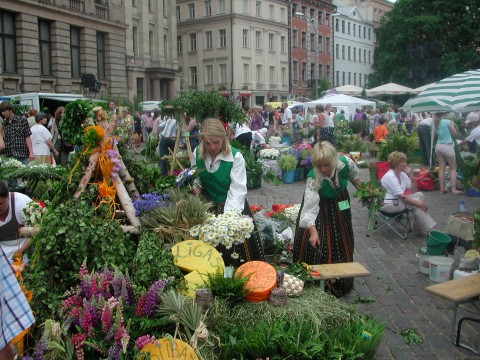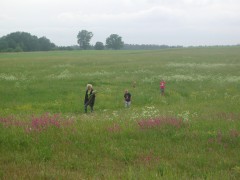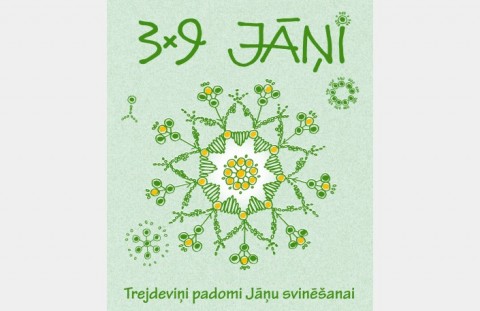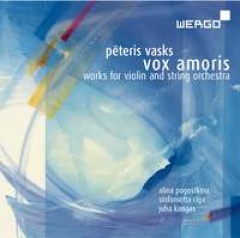
Traditional folklore group “Vilki” greeting the sun at sunrise on Jāņu rīts (morning). Photo: Daina Grosa.
According to Latvian tradition, those who sleep on Midsummer night (Jāņi) are doomed to sleep the whole summer—in other words, be lazy. Still to this day Jāņi is the biggest celebration of the year for Latvians, leaving in its shadow even Christmas.
Originally a fertility festival, Jāņi marks the longest day and the shortest night of the year: the summer solstice. Astronomically speaking, the solstice usually falls on the 21st of June, but Latvians tend to celebrate on the night from June 23rd to the 24th. The 24th is the “names day” of all men named Jānis, hence Jāņi. The celebration is often called Līgosvētki (the 23rd is the “names day” for Līga), although Jāņi (Jāņudiena, Jāņunakts) is the older and therefore more traditional name, even though the proper name Jānis itself is most likely not Latvian in origin.
Latvians traditionally spent an awful lot of time preparing for Jāņi: cleaning, cooking, finishing farmwork, fixing up the yard, weeding the garden, washing clothes, decorating, brewing beer, etc. Think how crazy Americans become after Thanksgiving.
Once Jāņi arrived people often went from farm to farm, visiting neighbors and friends, singing and bringing with them good luck for the fields and cattle. Grass supposedly grows better in those places where līgotāji (those who sing “līgo,” the typical refrain of Jāņi songs) have gone. That’s why they tried to walk past all of the fields. The hosts offered caraway cheese, pīrāgi and beer. A barrel full of tar was set on a pole and lit. Next to that blazed the bonfire. The fires were kept burning all night long so they would bring a good harvest to the fields and good health to the people. It was thought that the fields would be prosperous as far as the light from the fires shone, and that’s why hills were the optimal place for a Jāņi celebration, because the light shone farther from the higher elevation.
People still light bonfires and barrels of tar, eat cheese, pīrāgi and beer, and spend the night dancing and singing, laughing and visiting. The songs still often become teasing, obnoxious and risque, but no one takes lasting offence—it is a friendly and socially acceptable way to air grievances about others: “Pēteris is a lazy good-for-nothing!” “Kārlis has a long nose!” “Uldis lost his wife tonight!” “The girls are foolish for not letting me kiss them!” “Mārīte is round as a barrel!” etc. Every once in a while a young couple might wander off, supposedly in search of the mythical fern blossom. Of course, ferns don’t bloom, but who says you can’t look for it anyway!
Because all of nature is in full bloom at this time of year, flowers and grasses play a big part in the festivities. Many people carry tall grasses in their arms. Everything, including cattle and keyholes, is decorated with garlands, flowers and grasses. Jāņi is the best time of year to collect medicinal herbs—they’re said to be strongest then. All of the men and boys wear huge wreaths of oak leaves on their heads (the oak is the male symbol), while all women and girls wear wreaths of flowers. Because at other times during the year wreaths were traditionally worn only by unmarried women (married women wore scarves), no one knows at Jāņi just who is married and who isn’t; this tradition undoubtedly reminds us that Jāņi originated as a fertility festival. Does the Latvian birthrate really jump in late March, nine months after Jāņi? So I’ve heard.
Friends ask why we keep those dried flowers and leaves hung on our front door all year long. Those are our Jāņi wreaths from last summer, and we will throw them on this year’s Jāņi bonfire in order to get rid of the past year’s troubles and to start this year anew.
Because solstices were considered magical times, girls would sometimes do small rituals right at midnight to try to find out whom and when they would marry. Dew collected early the next morning was considered medicinal for humans, would ensure plentiful milk if given to cows, and would even repel flies if rubbed on barn ceilings. Jāņi night was also a prime time for witches’ activities, both good and evil.
Jāņi songs are often everybody’s favorites. With more than 2,000 melody variations, there are more songs for Jāņi than any other Latvian holiday. They do not have set texts, but singers are expected to improvise texts as the festivities go along. The typical refrain is “līgo,” and the songs have a lot of repetition, so that everybody can join in the singing. It is appropriate to start singing Jāņi songs a few weeks before the festival, and maybe a week or so afterwards, but they are out of place any other time of year.
You’re sure to find a Jāņi celebration almost anywhere there are a handful of Latvians. Some resemble the traditional festivities, down to the teasing songs and decorated keyholes. Others, both in Latvia and elsewhere, are unfortunately more like keg parties and rock music festivals. But at least you can find the obligatory bonfire pretty much anywhere. And, of course, beer. Probably that mild yellow caraway cheese, too.
So, find out about the Jāņi celebrations in your area, and go out next week to celebrate this ancient holiday!

Zāļu tirgus (Herb market) the day before Jāņi, an annual tradition in the centre of Rīga at Doma laukums. Photo: Arnis Gross.

Jāņu zāles are tradionally picked in the fields on Līgo vakars (Līgo night). All the flowers, grasses and leaves magically become “Jāņu zāles” on Līgo vakars. Photo: Arnis Gross.








